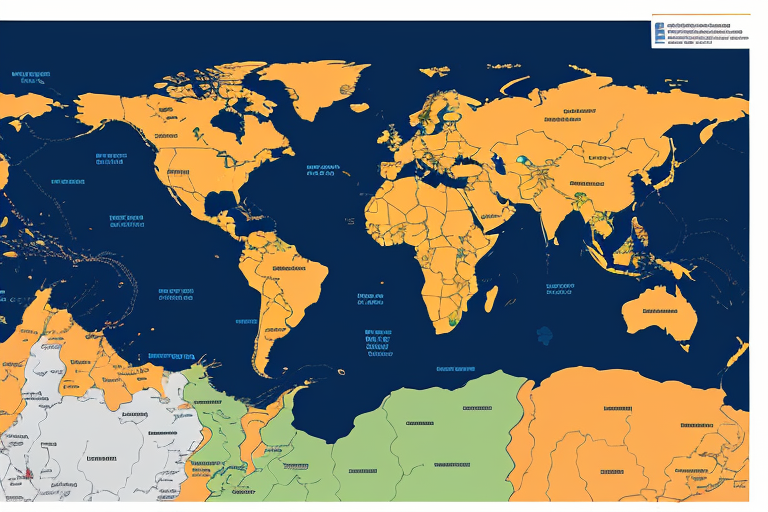China’s Belt and Road Initiative and Its Impact on Africa
The Belt and Road Initiative (BRI) is a massive infrastructure project launched by China in 2013. It aims to connect Asia, Europe, and Africa through a network of roads, railways, ports, and other infrastructure projects. The initiative has been hailed as a game-changer for global trade and economic growth, but it has also faced criticism for its potential to create debt traps and geopolitical tensions.
One area where the BRI has had a significant impact is Africa. China has invested heavily in infrastructure projects in African countries, including railways, highways, ports, and airports. These projects have the potential to boost economic growth and create jobs, but they have also raised concerns about debt dependency and foreign ownership.
It is essential to discuss the impact of the BRI on African countries because they are among the most vulnerable to the risks and challenges posed by the initiative. African countries have long struggled with underdeveloped infrastructure, limited access to international markets, and high levels of poverty and inequality. The BRI has the potential to address some of these challenges, but it also has the potential to exacerbate them.
In this section, we will explore the impact of the BRI on Africa in four key areas: infrastructure development, trade opportunities, investment opportunities, and risks and challenges. By examining these areas, we can gain a better understanding of the potential benefits and drawbacks of the BRI for African countries.
Infrastructure Development
One of the primary goals of the BRI is to develop infrastructure projects in participating countries. In Africa, China has invested heavily in railways, highways, ports, and airports, among other projects. These projects have the potential to improve connectivity, reduce transportation costs, and increase economic activity.
However, the quality and sustainability of these projects have been called into question. Some projects have been criticized for their poor construction quality, lack of maintenance, and limited local involvement. There are also concerns about the environmental impact of some projects, such as the construction of dams and other large-scale infrastructure projects.
Despite these concerns, the BRI has the potential to address some of the infrastructure challenges facing African countries. For example, the construction of new railways and highways can improve connectivity and reduce transportation costs, making it easier for African countries to access international markets. The development of new ports and airports can also boost economic activity and create jobs.
In the next section, we will examine the trade opportunities created by the BRI and their potential impact on African countries.
Building Bridges: China’s Infrastructure Development in Africa
China’s Belt and Road Initiative (BRI) has been a topic of much discussion in recent years, and for good reason. The initiative aims to connect Asia, Europe, and Africa through a network of infrastructure projects, including roads, railways, ports, and airports. In Africa, the BRI has led to the implementation of numerous infrastructure development projects, with the aim of improving connectivity and promoting economic growth.
One of the most significant infrastructure projects under the BRI in Africa is the Mombasa-Nairobi Standard Gauge Railway (SGR) in Kenya. The railway, which spans over 480 kilometers, was completed in 2017 and has since been operational. The railway has significantly reduced the time it takes to transport goods from the port of Mombasa to Nairobi, the capital city of Kenya. It has also created job opportunities for Kenyans, with over 30,000 people employed during the construction phase.
However, the quality and sustainability of some of the infrastructure projects under the BRI in Africa have been called into question. For example, the Maputo-Katembe Bridge in Mozambique, which was completed in 2018, has been criticized for its high cost and low usage. The bridge, which spans over 3 kilometers, was built at a cost of over $700 million, making it one of the most expensive bridges in Africa. However, it has been reported that the bridge is underutilized, with only a few hundred vehicles using it daily.
Despite the criticisms, China’s infrastructure development in Africa has had some significant benefits. For example, the BRI has led to the construction of new airports and ports in various African countries, which has improved connectivity and facilitated trade. The initiative has also created job opportunities for locals, with many African countries benefiting from the influx of Chinese workers during the construction phase of the projects.
However, the BRI has also had some drawbacks. One of the most significant concerns is the potential for debt dependency. Many African countries have taken out loans from China to finance the infrastructure projects, and there are concerns that some of these countries may struggle to repay the loans. This could lead to a situation where China gains control of strategic assets in these countries, such as ports and railways.
Another concern is the potential environmental impact of the infrastructure projects. Some of the projects have been criticized for their lack of environmental impact assessments, which could lead to negative consequences for the environment and local communities. For example, the construction of the Lamu Port-South Sudan-Ethiopia Transport (LAPSSET) Corridor in Kenya has been criticized for its potential impact on the Lamu Archipelago, a UNESCO World Heritage Site.
The Promise and Peril of Trade Opportunities
China’s Belt and Road Initiative presents significant opportunities for African countries to increase trade and economic growth. The initiative aims to develop a network of trade routes connecting China to Europe, Africa, and beyond. Through the initiative, China is investing heavily in infrastructure development in African countries, such as building ports, railways, and highways. These infrastructure projects are designed to facilitate the movement of goods and people, making it easier for African countries to trade with China and other countries along the trade routes.
One of the primary benefits of increased trade is economic growth. By increasing trade, African countries can access new markets and expand their economies. This expansion can lead to job creation, increased income, and improved standards of living for citizens. However, there are also potential risks associated with increased trade, such as neocolonialism and trade imbalances.
Neocolonialism occurs when a powerful country, such as China, uses its economic influence to gain political and social control over a weaker country. In the context of the Belt and Road Initiative, there is a risk that China’s investment in African countries could lead to a situation where China has significant control over the economies and political systems of those countries. This could lead to a loss of sovereignty for African countries and a situation where they become dependent on China for economic growth.
Another potential risk of increased trade is trade imbalances. Trade imbalances occur when one country exports more goods than it imports, leading to a situation where it has a surplus of foreign currency. In the context of the Belt and Road Initiative, there is a risk that African countries could become overly reliant on exports to China, leading to a situation where they have a surplus of Chinese currency. This could lead to a situation where African countries become dependent on China for trade and economic growth, leading to a loss of economic sovereignty.
The Potential Investment Opportunities of China’s Belt and Road Initiative in Africa
China’s Belt and Road Initiative has been a hot topic of discussion in recent years, with many African countries keen to leverage the initiative’s potential investment opportunities. Under the initiative, China has invested heavily in infrastructure development, including railways, highways, ports, and energy projects, across the African continent. These investments have the potential to create jobs, boost economic growth, and improve living standards in African countries.
One of the key advantages of China’s investment in Africa under the Belt and Road Initiative is the potential for job creation. The infrastructure projects being implemented in Africa require a significant amount of labor, which could provide employment opportunities for local communities. Additionally, the development of new industries and the expansion of existing ones could lead to the creation of new jobs in various sectors, including manufacturing, construction, and services.
Another advantage of China’s investment in Africa is the potential for economic growth. The infrastructure projects being implemented in Africa could improve the continent’s connectivity, making it easier for goods and services to be transported across borders. This could lead to increased trade and investment, which could, in turn, boost economic growth in African countries.
However, there are also risks associated with China’s investment in Africa under the Belt and Road Initiative. One of the main risks is debt dependency. Many African countries have taken on significant amounts of debt to finance infrastructure projects under the initiative. This could lead to a situation where African countries become heavily indebted to China, which could have negative consequences for their economies in the long run.
Another risk of China’s investment in Africa is foreign ownership. Many of the infrastructure projects being implemented in Africa are being built and operated by Chinese companies. This could lead to a situation where African countries become overly reliant on Chinese companies for their infrastructure needs, which could limit their ability to develop their own industries and create jobs.
Despite these risks, the potential investment opportunities presented by China’s Belt and Road Initiative in Africa are significant. African countries must carefully consider the benefits and drawbacks of these investments and develop strategies to mitigate the risks. This could include negotiating favorable loan terms, promoting local ownership and participation in infrastructure projects, and developing policies to promote economic diversification and reduce debt dependency.
Risks and Challenges
China’s Belt and Road Initiative has been praised for its potential to boost infrastructure development, trade, and investment in African countries. However, there are also significant risks and challenges associated with the initiative that must be carefully considered. In this section, we will examine some of the potential downsides of the initiative, including political and social risks, environmental impacts, and the potential for corruption and exploitation.
One of the most significant political risks of the Belt and Road Initiative is the potential for African countries to become overly dependent on China. As China invests billions of dollars in infrastructure projects and other initiatives in Africa, some experts worry that African countries may become beholden to China’s economic and political interests. This could lead to a loss of sovereignty and a lack of control over their own economic development.
Another political risk is the potential for conflict with other countries, particularly the United States. The Belt and Road Initiative has been viewed by some as a challenge to US global influence, and there are concerns that it could lead to increased tensions between China and the US. This could have negative implications for African countries caught in the middle of this geopolitical struggle.
In addition to political risks, there are also social risks associated with the Belt and Road Initiative. One concern is that Chinese companies may bring in their own workers to complete infrastructure projects, rather than hiring local workers. This could lead to a lack of job opportunities for local communities and exacerbate existing economic inequalities.
There are also environmental risks associated with the initiative. Many of the infrastructure projects being implemented in Africa under the Belt and Road Initiative involve the construction of dams, highways, and other large-scale projects that could have significant environmental impacts. These could include deforestation, habitat destruction, and increased greenhouse gas emissions, among other things.
Finally, there is also the potential for corruption and exploitation associated with the Belt and Road Initiative. Some experts worry that Chinese companies may engage in corrupt practices, such as bribing government officials or engaging in other illegal activities, in order to secure contracts for infrastructure projects. This could lead to a lack of transparency and accountability in the implementation of the initiative, as well as exploitation of local communities and workers.
Overall, while the Belt and Road Initiative has the potential to bring significant benefits to African countries, it is important to carefully consider the potential risks and challenges associated with the initiative. By doing so, African countries can make informed decisions about their involvement in the initiative and work to mitigate any negative impacts that may arise.









